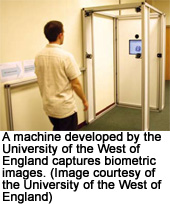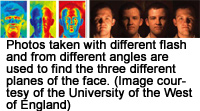Forget iris and fingerprint scans — scanning noses could be a quicker and easier way to verify a person’s identity, according to scientists at the University of Bath.
Forget iris and fingerprint scans — scanning noses could be a quicker and easier way to verify a person's identity, according to scientists at the University of Bath.
Unlike other facial features used for biometrics, noses are difficult to conceal and are not changed much by facial expression. Dr. Adrian Evans and Adrian Moorhouse, University of Bath faculty in electronic and electrical engineering, investigated whether images of people's noses could be used to recognize individuals.
A photographic system called PhotoFace was used to scan the noses of volunteers in 3-D. Researchers took three measurements:
1. The length of the nose ridge profile
2. The width of nose tip
3. The length of the nasion, or section between the eyes at the top of the nose
The curvature of the ridge was combined with the ridge length, and the ratio of the tip and nasion widths. This combined ratio was used to distinguish individuals using a database of 36 people. Computer software analyzed them according to six nose shapes: Roman, Greek, Nubian, Hawk, Snub and Turn-Up.
Distinctive Identity
Although only a few samples were used, nose scanning had good recognition and faster image processing rates compared to conventional biometric techniques, such as facial recognition.
 "Noses are prominent facial features, and yet their use as a biometric has been largely unexplored," Dr. Evans said. "We wanted to find out how good they could be at recognizing individuals from a database."
"Noses are prominent facial features, and yet their use as a biometric has been largely unexplored," Dr. Evans said. "We wanted to find out how good they could be at recognizing individuals from a database."
The contactless method has advantages. "Where iris and fingerprint recognition are quite invasive procedures, either requiring physical contact — in the case of the fingerprint, or in most cases of close up images of one's iris — the PhotoFace method used for capturing the data is achieved simply by walking through a doorway," Moorhouse said.
"We've only tried this on a small sample of people, but the technique certainly shows potential, perhaps to be used in combination with other identification techniques," Dr. Evans said.
Melvyn Smith led a team at the University of the West of England (UWE) who developed the PhotoFace system. "This collaborative project with Bath is very exciting work with great potential," Smith said. "It works by taking photos, lit by a flash from several different angles, so that four images are taken in very rapid succession of every point on the face, each under different controlled lighting conditions. The technique is known as photometric stereo and UWE's Machine Vision Laboratory is one of only three UK centers with expertise in this area."
 "The software then works out the color, surface orientation and depth of each point on the face by analyzing the shading within each of the photos," Smith said. "The technique is able to achieve a level of detail that is beyond current competing technologies and can be extended to a myriad of other applications. We recently completed a project for the UK Ministry of Defense, where we used photometric stereo to reveal hidden and camouflaged objects, such as weapons."
"The software then works out the color, surface orientation and depth of each point on the face by analyzing the shading within each of the photos," Smith said. "The technique is able to achieve a level of detail that is beyond current competing technologies and can be extended to a myriad of other applications. We recently completed a project for the UK Ministry of Defense, where we used photometric stereo to reveal hidden and camouflaged objects, such as weapons."
Using the nose as a biometric is still in the developmental stage. "Although promising, I am not sure the nose itself is robust enough," Smith said. "We may have to expand the region of the face which we use, to an area that is slightly larger than just the nose."
Nose recognition holds potential, once fully developed. "An obvious choice for such technology would be in airports, where the current device could be easily mounted onto existing frames — such as doorways and metal detectors — where only minor alterations are required," Moorhouse said.
Product Adopted:Biometrics